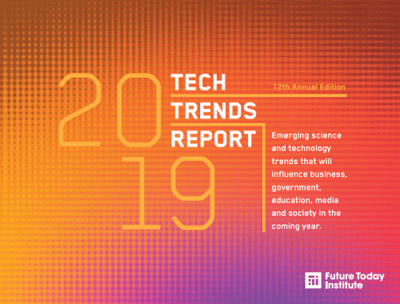What’s Happening:
Tech Trends Report from the Future Today Institute (FTI) is its 12th publication, and the biggest report ever with a 30% increase over the 225 trends identified last year. This increase to covering over 300 is largely due to the advancement of so many different technologies, causing acceleration across many fields including digital publishing.
Why it Matters:
The 2019 Tech Trends Report, released in March, has already received more than 7.5 million views and includes trend breakdowns by industry including banking, beauty, science and others. It’s geared towards Fortune 500 companies as well as small businesses and startups, along with non-business entities such as universities and governments.
During the release at the SXSW Festival in Austin, Texas, FTI director and New York University Stern School of Business professor Amy Webb said that many organizations aren’t thinking the right way about how far into the future they should be making plans.
Digging Deeper:
The report advises organizations that to effectively plan for the future, they need to learn how to think about time differently. “Start retraining yourself to think about change and disruption to your organization and industry across different timeframes and build actions for each.” This suggested timeline is:
- The next 12-36 months: tactical actions
- In 3-5 years: strategic action
- In 5-10 years: vision and R&D initiatives
- For 10+ years: how you and your organization can create
The report includes 48 scenarios for things like a collision between autonomous driving data and regional privacy laws, flying taxis, and drones as a source of renewable energy: 17 optimistic, 20 pragmatic, and 11 catastrophic. Also provided are nine foresight tools and frameworks that can be implemented by organizations to advance strategic thinking on the trends outlined in the report. And, five primers are intended for executive leadership and management, covering Artificial Intelligence, Autonomous Transportation, Mixed Reality, Genetic Editing and Blockchain.
The overview of artificial intelligence (AI), which is a trend that has been included in the report for the past 10 years, solidifies China’s status as the emerging world leader in AI. “No other country’s government is racing toward the future with as much concentrated force and velocity as China,” it states.
Other key highlights of the 2019 Tech Trends report include:
- AI: Bias, and its real-world consequences, continues to be a problem with AI that needs to be paid close attention to. AI services from cloud providers is also highlighted as a major trend, and consolidation of talent and resources by dominant companies such as Amazon, Google and Alibaba will continue. AI chipsets and unique programming languages for AI frameworks may also become a trend.
- Data: Data governance and retention policies and data lakes are being adopted by more organizations. While personal data records (PDR) that include information such as school, work, financial, legal and travel history don’t currently exist, but the report says there are signals which indicate PDR could quickly become unified under one record maintained by the Big Nine companies.
- Personal recognition: Facial recognition, unique voice signatures, emotion detection, bone structure detection, and even personality recognition, along with synthetic biometrics, are beginning to emerge. Not only marketers, but also industries like the legal field and political campaigns are beginning to use these technologies.
- Surveillance: Law enforcement use of systems like Amazon’s Rekognition and persistent audio surveillance systems that can listen to and analyze conversations are on the rise. Wi-Fi and radio waves can be used to identify a person’s location, sleep cycle, and emotional state.
- Audio and smart speakers: The use of voice-activated smart speakers is a strong continuing trend, with approximately 40% of U.S. households predicted to own smart speakers by the end of 2019. By 2020, the report estimates that half of searches will be done with voice. Ambient computing in vehicle infotainment systems is also part of the “voice assistant wars.”
- Intelligent machines and robots: Soft and molecular robotics, as well as teams of robots working together and human-machine collaboration, are identified as trends this year — along with robot abuse or attacks by people.
- Transportation: Autonomous vehicles designed for last-mile travel or services like food delivery are predicted to grow in adoption. Drone operation centers for fleet management, autonomous ships, underwater vehicles, and the return of supersonic commercial air travel are also identified.
- Smart cities: For the second year in a row, the report identifies the world’s smartest cities — those with initiatives for smart buildings, waste reduction, abundant public Wi-Fi hotspots, and 4G or 5G connectivity.
The smartest city in the world is named as Copenhagen, Denmark, with all of the top 10 cities in Nordic nations of Denmark, Finland, Sweden, and Norway. Europe (including the UK) had 13 cities, Asia 9, North America 8, Middle East 4, and South America, Australia and India each had one. No African cities made the list for 2019.
The Bottom Line:
With so much uncertainty today, the FTI report aims to provide answers about the most important emerging tech trends that are most likely to impact business, governing and society in the near future.
Content from our partners
“It’s time to get comfortable with deep uncertainty,” Webb says. “Leaders often make common errors as they make strategic decisions about the future: they either under-predict or over-predict change. The reason? Most of us find uncertainty uncomfortable, so we are reluctant to confront it.”
While people and organizations cannot solve for future uncertainty, Webb continues, they can prepare themselves to think strategically using data-driven signals, trends and outcomes. “Focus on connections, not predictions. Doing so will help your organization get ahead of disruption in order to build your preferred futures.”












